Many farmers, especially cereal growers, have changed the traditional crops, which they have sowed for years, to alternative crops in order to increase the profitability of woody crops such as almonds, olives and pistachios. One of these alternative crops is Paulownia so we are going to give you more details about it in the following paragraphs.
Characteristics, requirements and management
Whenever you hear about Paulownia, you will hear about the fastest growing, most profitable and fastest tree in the world, which also helps to combat climate change. However, what are the most important details? This crop has been grown in Spain for many years, but it is only today becoming important because the industry is looking for these materials and the sale of wood is easier than before. The demand for sustainable building materials is currently on the rise and fast-growing trees are very important. Paulownia exists all over Europe, but it is in warm, irrigated regions where these trees have the most potential, especially in Spain and Italy. Paulownia trees can grow up to 4 metres in the first year, which in some varieties such as "Phoenix One®" begin to be harvested in the fifth year after planting.
We have contacted the WeGrow company (Talavera de la Reina-Toledo). It has more than 600 ha in Europe (300 ha in Castilla-La Mancha area) to know the requirements of this crop. In addition, WeGrow sells plants, provides technical advice and buys timber. After more than 10 years managing plantations, they are specialist in studying the crop, identifying the necessary requirements and optimising yields.
The most important aspects to know are the following:
- It is a very fast growing plant and adapts to poor soils, but getting the maximum yield requires maintenance of the trees.
- It is important to know the limiting factors, in order to choose the right fields.
- Profitability is high because the price of timber is high, in spite of the costs of establishing the crop.
The conditions for cultivation:
- Except for certain areas, it is an irrigated crop, which is drip irrigated in quantities of 2,500 to 3,000 m3/ha per year.
- Soils should have a low clay content, more than 40% clay is not recommended. In addition, soils must be deep and not have a water table near the surface.
Management:
- Planting frames: WeGrow works with varieties that allow intensive cultivation, with frames of 3x4 metres with the "Phoenix One®" variety. With other varieties, the frames are wider, depending on the canopy width, with frames of up to 6x6 metres.
- Soil preparation tasks are very similar to that of other woody crops, with deep and medium tillage during the winter.
- The first year is the most intensive in terms of maintenance because the trees grow very fast and require continuous pruning.
- The work decreases from the second year onwards because the trees already have the structure formed.
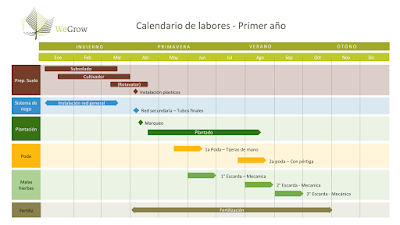
|
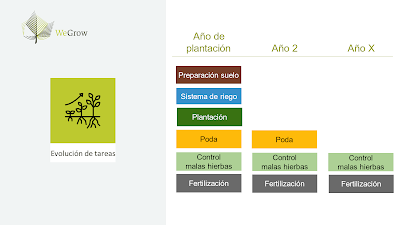
|
Paulownia can be grown for timber or biomass but the value of the second is very low. In contrast, the price of timber has been high and stable over the last few years. The costs of establishing the crop are about 9,000 €/he. After that, annual maintenance costs are around 1,000 €/he.
The cultivation cycle is 7 years. A thinning is done at 5 years of age and the final cut at 7 years of age. After cutting, trees resprout up to 3 times, giving 2 more harvests. The average amount of wood produced in each cycle is 0.6 m3 per tree. From the age of 21 years, the ideal is to replant and start again.
Currently, WeGrow offers what they call the "Growing Partner Programme" to guarantee the purchase of timber. This year, the timber contracts of the new Growing Partners have set prices from 110€ to 160€ per cubic metre of timber, depending on the diameter. These prices are 15% higher than 2020 prices.
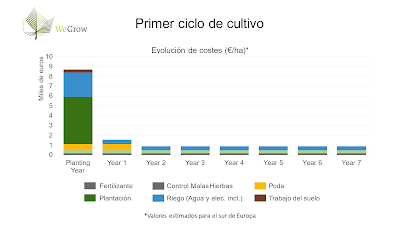
|
Competing crops
Nowadays there is a clear focus on high-value crops and many farmers are converting their farms to the alternative crops of the moment: almond, pistachio, etc. Among these high-value crops is Paulownia for timber. It also has certain advantages that, provided the growing area is suitable, make it a great choice. The initial investment is higher than for other crops but the return on investment is earlier than for crops such as pistachio or almond trees. On the other hand, the profitability of selling Paulownia wood is more profitable and the demand for this product is growing. Other products such as almonds and pistachios have a large market, but demand is not growing and the number of farms producing these fruits is increasing every year. Therefore, Paulownia has a great competitive advantage.
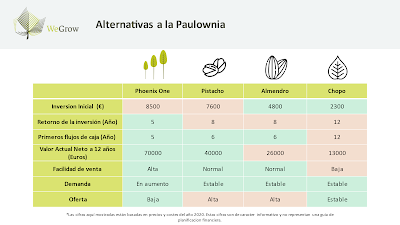
|
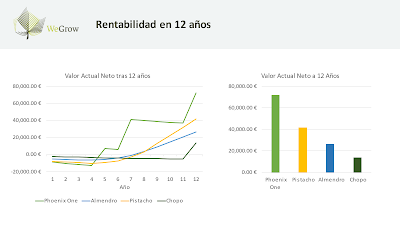
|
WeGrow recommends us to be very demanding when determining whether or not our soil is suitable for this crop. The success of a Paulownia plantation is marked by two factors: the correct choice of site and variety, and rigorously following the schedule of maintenance operations. If you follow these two steps well, they indicate that success is very high because in recent years the price of timber has risen steadily and continuously.
Paulownia has a second product: carbon sequestration. The rapid growth of Paulownia has the effect of capturing CO2 from the atmosphere in higher quantities than other crops or a traditional forest. One kilogram of wood stores the carbon of 1.6 kg of CO2, so extrapolating this to cultivation, in the case of Paulownia, this translates into 40 tonnes per hectare per year, 10 times more than traditional forest crops.















